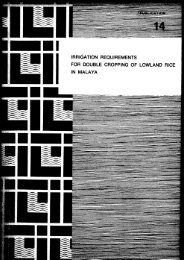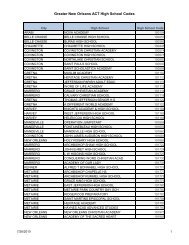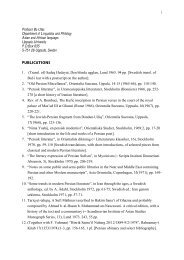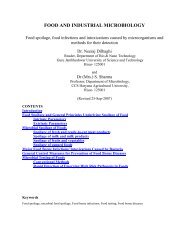On the Future of Indigenous Traditions - Munin
On the Future of Indigenous Traditions - Munin
On the Future of Indigenous Traditions - Munin
Create successful ePaper yourself
Turn your PDF publications into a flip-book with our unique Google optimized e-Paper software.
3.2.2. Historical Benchmarks<br />
In this section I shall be talking <strong>of</strong> <strong>the</strong> issue <strong>of</strong> legitimacy <strong>of</strong> <strong>the</strong> Adivasis’ political<br />
association which was our second point for discussion in this series. There were<br />
nearly nine major historical benchmarks in <strong>the</strong> British India around and after Adivasi<br />
resistances and insurgencies that laid down provisions in <strong>the</strong> administration that<br />
would acknowledge or recognize <strong>the</strong> presence <strong>of</strong> Adivasis in respective areas. These<br />
rules were aimed to have better control over Adivasi land, forests, and resources for<br />
taxation through <strong>the</strong> landlord system, which was strongly challenged, by Adivasi<br />
insurgency and uprisings. Among <strong>the</strong>se policies and plans for <strong>the</strong> ‘tribal areas’ were<br />
as following 93 :<br />
1. The Bengal Act, XIII, <strong>of</strong> 1833: It was <strong>the</strong> first setup for Jharkhand region to be<br />
accepted as an area outside <strong>the</strong> operation <strong>of</strong> general laws. This area was kept under<br />
<strong>the</strong> agent <strong>of</strong> governor – general.<br />
2. Cleveland’s Hill Assembly Plan for Rajmahal Hills <strong>of</strong> Santhal Pargana: <strong>the</strong><br />
policy to provide arms to Paharia archers like regular police and transfer <strong>the</strong> cash <strong>of</strong><br />
Paharias to <strong>the</strong> tribunal <strong>of</strong> <strong>the</strong> chief. Mr Cleveland to this end established regular<br />
market here encouraging Adivasis for selling forest produces in <strong>the</strong> haat or local<br />
market.<br />
3. Wilkinson Act: <strong>the</strong> agent <strong>of</strong> Governor, General Captain T. Wilkinson established<br />
an act for <strong>the</strong> judicial administration in <strong>the</strong> tribal area <strong>of</strong> Chota Nagpur. In this act <strong>the</strong><br />
traditional role <strong>of</strong> Munda, Mankis, and o<strong>the</strong>r village functionaries were accepted in<br />
<strong>the</strong> local administration.<br />
4. Act 1855: After <strong>the</strong> Santhal insurgency <strong>the</strong> dami-e-koh and o<strong>the</strong>r Adivasi districts<br />
were made free from <strong>the</strong> influence <strong>of</strong> common rule.<br />
5. Act 1870: Due to strong oppositions by <strong>the</strong> Adivasis <strong>of</strong> <strong>the</strong>ir land being grabbed by<br />
non-Adivasis, special rules were formulated to save <strong>the</strong> transfer <strong>of</strong> Adivasi land. The<br />
93 Ibid., 10-12.<br />
62

















